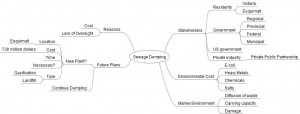Raw Sewage Dumping from Victoria B.C.
Since 1915 the Capital Regional District (Victoria and surroundings) has been dumping raw sewage into Ross Bay. Roughly 6.7 million kilograms of solids annually (GORDON, 2014) are pumped out along long flow pipes and discharged into the ocean. The problem of sewage treatment (or lack thereof) in Victoria is a very complex problem and does classify as a wicked problem. There are multiple sides and stakeholders to the issue. Not only does this affect the residents of the Capital Region, but also potentially residents of the San Juan Islands in Washington State (Meissner, 2014). This brings an international aspect to the problem (it transcends political/regional boundaries). Within the region there are various stakeholders as well. Residents of the communities in the region cannot agree on where to build a treatment plant, what kind of treatment plant, or even if a treatment plant is necessary. Experts as well disagree on the necessity of a plant, some claim evidence is lacking to justify the expenditure of nearly a billion dollars. They claim that the depth of the outflow pipes and the contents of the outflow are dispersed harmlessly into the ocean (Responsible Sewage Treatment Victoria, 2014). Others cite E-coli measurements higher than is recommended for healthy waters. Various levels of government are also involved. New standards created by the federal government also create a push for a plant. The stakeholders are many and varied. Information on the problem is also difficult to obtain and is often controversial. Gathering new data would be expensive and the existing studies are few and contradictory. Construction of a new treatment plant would possibly cost upwards of 700 million Canadian dollars. (Hopper, 2013) This would raise taxes for local residents by 200 to 400 dollars annually. (Hopper, 2013) This further divides residents on the issue. All of these factors and others combine to move what seems to be a simple problem, dumping waste, with a simple solution, build a modern treatment plant, into a wicked problem.
The mind map I have developed is a conceptual layout to help me formulate the problem. My main links off the central problem of sewage dumping are, Stakeholders, Environmental Costs, Future Plans, Marine Environment, and Reasons. I consider these to be the main aspects of the problem I need to focus on and expand to help define the wicked problem. Each of these sub headings are further broken down into more detailed levels. Within Stakeholders I look at the different stakeholders I can initially imagine as well as various divisions and levels that exist within them. For example the varying levels of governments involved. One major heading I believe to be important is Future Plans. Whether or not a treatment plant needs to be built, who will pay for it, where will it be built, etc.
Bibliography
GORDON, K. P. (2014, June). Focus Online. Retrieved from Focus Online: http://focusonline.ca/?q=node/735
Hopper, T. (2013, November 1). National Post. Retrieved from National Post: http://news.nationalpost.com/news/canada/is-a-783m-victoria-sewage-plant-necessary-or-the-largest-boondoggle-in-canadian-history
Meissner, D. (2014, June 11). The Globe and Mail. Retrieved from The Globe and Mail: http://www.theglobeandmail.com/news/british-columbia/victoria-sewer-dispute-hits-the-fan-as-washington-state-urges-bc-intervene/article19131685/
Responsible Sewage Treatment Victoria. (2014). Responsible Sewage Treatment Victoria. Retrieved from Responsible Sewage Treatment Victoria: http://www.rstv.ca/is-victoria-dumping-raw-sewage/
